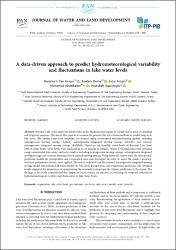| dc.contributor.author | Kesgin, Remziye İlayda Tan | |
| dc.contributor.author | Demir, İbrahim | |
| dc.contributor.author | Kesgin, Erdal | |
| dc.contributor.author | Abdelkader, Mohamed | |
| dc.contributor.author | Ağaçcıoğlu, Hayrullah | |
| dc.date.accessioned | 2025-03-25T12:09:03Z | |
| dc.date.available | 2025-03-25T12:09:03Z | |
| dc.date.issued | 2023 | en_US |
| dc.identifier.citation | KESGİN, Remziye İlayda Tan, İbrahim DEMİR, Erdal KESGİN, Mohamed ABDELKADER & Hayrullah AĞAÇCIOĞLU. "A Data-Driven Approach to Predict Hydrometeorological Variability and Fluctuations in Lake Water Levels". Journal of Water and Land Development, 58.7-8 (2023): 158-170. | en_US |
| dc.identifier.uri | https://www.jwld.pl/files/2023-03-JWLD-18.pdf | |
| dc.identifier.uri | https://hdl.handle.net/11352/5255 | |
| dc.description.abstract | Beyşehir Lake is the largest freshwater lake in the Mediterranean region of Turkey that is used for drinking and irrigation purposes. The aim of this paper is to examine the potential for data-driven methods to predict long-term lake levels. The surface water level variability was forecast using conventional machine learning models, including autoregressive moving average (ARMA), autoregressive integrated moving average (ARIMA), and seasonal autoregressive integrated moving average (SARIMA). Based on the monthly water levels of Beyşehir Lake from 1992 to 2016, future water levels were predicted up to 24 months in advance. Water level predictions were obtained using conventional time series stochastic models, including autoregressive moving average, autoregressive integrated moving average, and seasonal autoregressive integrated moving average. Using historical records from the same period, prediction models for precipitation and evaporation were also developed. In order to assess the model’s accuracy, statistical performance metrics were applied. The results indicated that the seasonal autoregressive integrated moving average model outperformed all other models for lake level, precipitation, and evaporation prediction. The obtained results suggested the importance of incorporating the seasonality component for climate predictions in the region. The findings of this study demonstrated that simple stochastic models are effective in predicting the temporal evolution of hydrometeorological variables and fluctuations in lake water levels. | en_US |
| dc.language.iso | eng | en_US |
| dc.publisher | Polish Academy of Sciences (PAN) & Institute of Technology and Life Sciences – National Research Institute (ITP – PIB) | en_US |
| dc.relation.isversionof | 10.24425/jwld.2023.146608 | en_US |
| dc.rights | info:eu-repo/semantics/openAccess | en_US |
| dc.subject | Evaporation | en_US |
| dc.subject | Lake Water Level | en_US |
| dc.subject | Precipitation | en_US |
| dc.subject | Stochastic Time Series Models | en_US |
| dc.subject | Water Transfer | en_US |
| dc.title | A Data-Driven Approach to Predict Hydrometeorological Variability and Fluctuations in Lake Water Levels | en_US |
| dc.type | article | en_US |
| dc.relation.journal | Journal of Water and Land Development | en_US |
| dc.contributor.department | FSM Vakıf Üniversitesi, Mühendislik Fakültesi, İnşaat Mühendisliği Bölümü | en_US |
| dc.contributor.authorID | https://orcid.org/0000-0001-9135-1698 | en_US |
| dc.contributor.authorID | https://orcid.org/0000-0002-2734-4116 | en_US |
| dc.contributor.authorID | https://orcid.org/0000-0002-9441-5359 | en_US |
| dc.contributor.authorID | https://orcid.org/0000-0002-7655-5737 | en_US |
| dc.contributor.authorID | https://orcid.org/0000-0002-1860-9848 | en_US |
| dc.identifier.volume | 58 | en_US |
| dc.identifier.issue | 7-8 | en_US |
| dc.identifier.startpage | 158 | en_US |
| dc.identifier.endpage | 170 | en_US |
| dc.relation.publicationcategory | Makale - Uluslararası Hakemli Dergi - Kurum Öğretim Elemanı | en_US |
| dc.contributor.institutionauthor | Kesgin, Remziye İlayda Tan | |



















